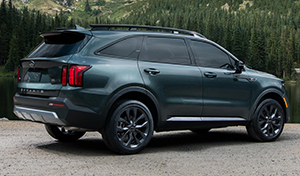2021 Kia Sorento
As Kia’s longtime standard bearer in the midsize SUV field, the Sorento has seen a lot of changes in its 3 generations. But now with its larger Telluride in the mix, there’s time for even more, as the Sorento takes on a new role. So let's find out what that is.
While not the first SUV in their lineup, the Kia Sorento is truly one of the vehicles that laid the foundation for Kia’s success today. An all-new one arrives for 2021, looking to build upon that foundation with more capability, technology, and refinement than ever; yet does so with an eye on the past.
When Kia added the Sorento to their lineup for 2003; they wanted a rugged, capable utility. So, even without a pickup truck in their lineup to base it on, they built the Sorento on a full truck-style frame; designed to look like a Lexus, but perform like a 4Runner. Those 1st gen. Sorentos still have quite a following in the off-road community. But, following trends, Kia quickly made the shift to a uni-body platform for 2011, and has never looked back.
 Until now, as Kia would clearly like to get back to that former image; although just partially, as with the launch of the 4th gen. Sorento there’s no full frame, but it does have an available X-Line package with an upgraded all-wheel-drive system that includes a locking center diff and downhill descent control.
Until now, as Kia would clearly like to get back to that former image; although just partially, as with the launch of the 4th gen. Sorento there’s no full frame, but it does have an available X-Line package with an upgraded all-wheel-drive system that includes a locking center diff and downhill descent control.
Plus, 1-inch of additional ground clearance, unique bumpers front and rear, roof rack, and 20-inch matte finish alloy wheels.
And indeed the overall design for all ’21 Sorentos is more reminiscent of the original Sorrento than current Kia status symbol Telluride; wheelbase is stretched 1.4-inches over last year.
The biggest downside here, is that you’re not necessarily getting a knockabout off-road spec rig, as you must add the X-Line on top of the lavishly outfitted and pricy top SX Prestige trim.
So, while the rugged styling elements are in play outside; inside, it’s very feature intensive, and quite luxurious, think more Land Rover than 4Runner Sport.
That means a 12-inch fully digital gauge display, packed with so much info, there’s not much reason to look over at the central 10-inch touchscreen when driving. Though gazing at the Surround View Monitor will certainly help in parking and off-road situations.
If you need 3-row flexibility, don’t worry, they haven’t given that over fully to the Telluride, you still get 3 rows standard here; with either bench or captain’s chairs in 2nd row, giving 7 or 6 passenger capability.
The stretched wheelbase provides a little more room inside for both people and cargo; 12.6 cu-ft. behind the 3rd row, 38.5 behind the 2nd, and a max of 75.5 with all seats folded.
 You will have to step up to the Telluride if you want a V6 engine, or to tow more than the Sorento’s max of 3,500-lbs., as there’s now an all 4-cylinder lineup here, but a comprehensive one.
You will have to step up to the Telluride if you want a V6 engine, or to tow more than the Sorento’s max of 3,500-lbs., as there’s now an all 4-cylinder lineup here, but a comprehensive one.
A naturally aspirated 2.5-liter I4 with 191-horsepower is standard, but most Sorentos will likely come equipped with the turbo version of that engine packing almost 100 more ponies at 281-horsepower and 311 lb-ft. of torque. A 1.6-liter based Hybrid is also available, with a PHEV coming soon, bringing 30-miles of EV-only range with it.
The turbo also comes with an upgraded 8-speed dual clutch automatic transmission; same setup found in the K5 GT sedan, albeit with a few less horsepower.
So equipped, we took our X-Line test rig to the track. Attempting to fit runs in between springtime pop-up showers meant a damp surface and a slow 8.9-second launch to 60. In the dry we know it is at least a second faster.
Once we were able to take full advantage of all that torque, things improved a bit, working our way to a 16.7-second 1/4-mile at 83 miles-per-hour.
Despite the additional inch of ground clearance, there wasn’t as much body roll as we anticipated in our slalom course. The Sorento stayed well-composed with only mild understeer and refreshingly little computer intervention.
Not that there isn’t assistance when you need it; 16 Kia Drive Wise Driver Systems available, with Forward Collision-Avoidance Assist standard.
 And brakes were certainly up to the task, stopping us from 60 in just 100-feet; with minor fade but great pedal feel.
And brakes were certainly up to the task, stopping us from 60 in just 100-feet; with minor fade but great pedal feel.
Government Fuel Economy Ratings are 21-City, 28-Highway, and 24-Combined.
That equals an average Energy Impact Score, consuming 13.7-barrels of oil yearly, with 6.2-tons of CO2 emissions.
Pricing starts at $30,565; certainly competitive for the segment. All-wheel-drive is a $1,800 option for all trims except for SX Prestige; where it’s included in the $2,000 X-Line package.
With the Telluride now giving larger families a better option, there’s room in the Kia lineup for the Sorento to become a little more daring, and Kia has embraced that. The 2021 Sorento still offers the technology, comfort, and features that families are looking for these days, but with an adventure-ready X-factor that makes it more desirable than ever.
Specifications
- Engine: 2.5L I4 Turbo
- Horsepower: 281
- Torque: 311 lb-ft
- 0 - 60mph: 8.9 seconds
- 1/4 Mile: 16.7 seconds @ 83 mph
- EPA: 21 City / 28 Highway / 24 Combined





